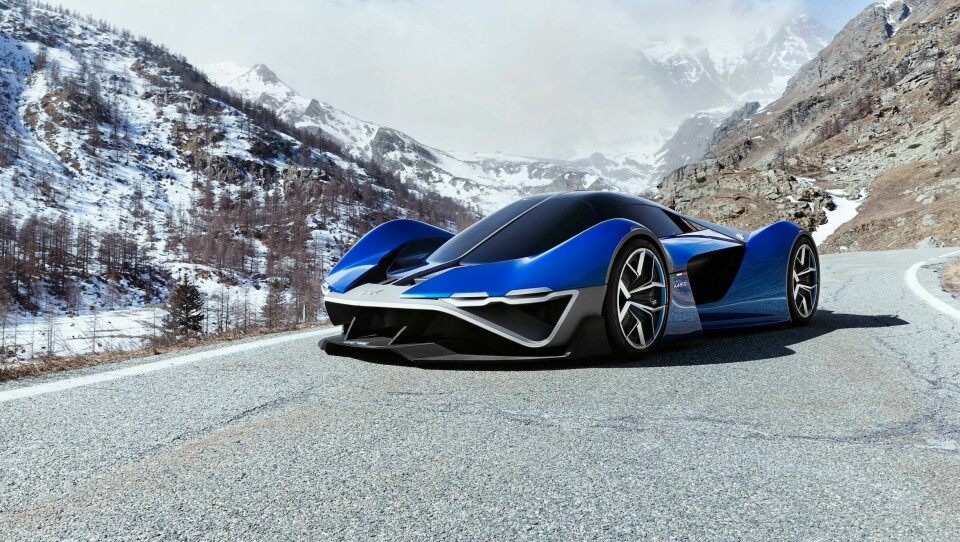
IED and Alpine create ornate concept car
Students at IED have produced an ultra-sporty concept car in collaboration with Alpine, aimed at showcasing both eco-friendly and fun-to-drive technologies
The Istituto Europeo di Design (IED) in Italy has collaborated with French carmaker Alpine to create a two-seater hydrogen-powered concept car. Called ‘A4810 Project by IED’, it was unveiled during a livestream broadcast from OGR Tech in Turin.
“Collaboration with the Istituto Europeo di Design and its students has been a great experience,” said Antony Villain, Alpine design director. “It was a ‘filter’ for us to see the brand through the eyes of the younger generation, but it was also an opportunity to share our passion and know-how, and give them sound advice for a successful career in automotive design.”
A total of 28 students on the Transportation Design course took part in the collaboration. The group was given a brief by Alpine, tasking them to create a ‘super berlinette’ for the year 2035 while simultaneously staying true to the traditional design characteristics of the French company. Students initially worked individually before presenting their ideas to Villain and his team, who then handpicked two designs. These formed the basis of the final concept car.
Inspired by Formula 1 models, the dramatic exterior was crafted to be aerodynamic and lightweight. It measures 5,091mm in length, 2,010mm in width and 1,055mm in height, with a wheelbase of 2,717mm. Enormous air intakes, bulging wheel arches and sharp angles in the body work all add to the aggressive appearance of the concept, while the large dome-like greenhouse is placed almost delicately at the centre. At the front, the upper part of the body finished in a striking blue tone overlaps and sits on top of the light grey fascia. In between these sections is an open area for air flow, while the lower section of the front includes a thin carbon-fibre splitter and more open spaces for air.
The sides of the car are dominated by the giant wheel arches and large air outlets behind the front tyres. This creates a split in the body work, with the front and rear sections separated by a large black glossy section positioned beneath the greenhouse. The rear section is connected to the greenhouse by thin metal pillars. Two simple lights emphasise the width of the rear, running vertically behind the wheels like fins. Between them is a large open section to compensate for those air intakes at the front, with a big diffuser at the bottom arching up to form an ‘M’ shape and a third, razor-thin light dissecting the rear through the middle.
Inside, a cockpit cabin was created entirely through the use of digital tools. It is dominated by the large racing steering wheel that projects out from a complex IP, with various movable layers operating to enhance driver control. Two bucket seats, cladded in white leather-like material, are placed inside their zones and divided by a thin light element and a rudder-like, illuminated transparent panel that is similar to the fins on the rear of the car. Elsewhere, carbon-fibre inserts and 3D patterned fabric surround the occupants, creating a textured cocoon.
Although it looks to be extreme and perhaps an exercise in crystal ball gazing, Villain and his team suggested that the concept car is an important step for Alpine and its exploration of new packaging ideas, proportions and design language development. It is also difficult to identify physical elements of the new concept that reflect traditions of Alpine design, particularly when placed next to icons like the A310 and A110. However, the ‘A4810’ is named after Mont Blanc – the highest peak in the Alps that borders Italy and France, which measures 4,810 in metres.
Paola Zini, director of IED Turin, was keen to offer his thoughts on the collaboration, praising the students for their work. “As in previous years, through their most important project, the Masters students have embraced notions of skill transversality and teamwork in a fertile and visionary environment,” he said. “This is part of the IED DNA and will help prepare students for the challenges the industry will face in the future, and serve as a foundation for their professional success. Alpine’s contribution was one of passion, enthusiasm, and constant presence, and marks another milestone in international collaboration.”





















